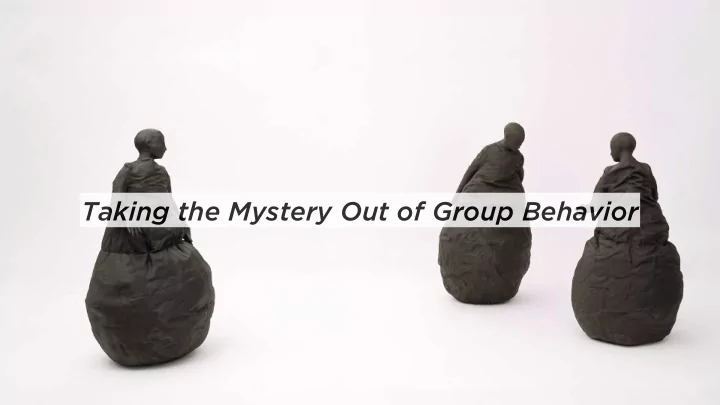

Taking the Mystery Out of Group Behavior
OVERVIEW INTRODUCTION TO GROUP DYNAMICS • ASPECTS OF GROUP DYNAMICS • MODELS FOR UNDERSTANDING GROUP DYNAMICS • GUIDELINES FOR BETTER GROUP DYNAMICS GROUP FORMATION • THEMATIC CLUSTERING EXERCISE *BREAK GROUP EXPECTATIONS • GROUP EXPECTATIONS DOCUMENT GROUP PROJECT • GROUP PROJECT BRIEF WORKSHEET
Is a good team dynamic the result of luck or ability ?
Patterns of Dominant U.S. Culture Communication Style • English is the spoken language and many are not fluent in a second language • Speakers often interrupt and do not connect previous comments • Messages use explicit and direct verbal communication • Content is intellectual and depersonalized Conflict Style • Intent is to find solutions • Method is logical and unemotional • Conflict is something to be avoided, or if addressed, to be dominated
Patterns of Dominant U.S. Culture Individualism/Collectivism • Relationships start and end quickly; boundaries are loose • Groups often have marginal and excluded members • Achievement is valued • Identity is based on oneself Task/Relationship • Things get done by following procedures in a linear manner • Attention to relationships, feelings, and process is minimal • Outside authority and empirical evidence is valued Leadership • Decision-making is somewhat decentralized. • Leaders are somewhat directive and tend to individual needs
Andrews, Rita J. “Being the Only”
Gallant, Susan M. “Cultural Assumptions in Cross-Cultural Relations”
A father and son are in a horrible car crash that kills the dad. The son is rushed to the hospital; just as he's about to go into surgery, the surgeon says, “I can't operate—that boy is my son!”
“What are the hidden biases of [good people]? They are--for lack of a better term--bits of knowledge about social groups. These bits of knowledge are stored in our brains because we encounter them so frequently in our cultural environments. Once lodged in our minds, hidden biases can influence our behavior toward members of particular social groups, but we remain oblivious to their influence. Banaji, Mazhzarin R., Anthony G. Greenwald : Blindspot: Hidden Biases of Good People, 2013
Becoming Aware of the Art of Listening Becoming an Active Listener • Pay attention, don’t fake your understanding. • Listen for total meaning (message, emotional content, nonverbal behavior) • Don’t give advice , instead offer feedback . Traps that prevent Active Listening • Encouraging the ‘shoot and reload’ conversation. • Directing the speaker by bringing the conversation in a direction you want • Satisfying your personal needs by probing, asking too many questions • Being judgmental, injecting your personal values and opinions into the conversation • Smoothing over conflict by making light of the other person’s personal problems • Parroting back to the speaker exactly what he or she said.
Becoming Aware of Feedback Guidelines for Constructive Feedback • DESCRIBE vs. interpret the behavior • Provide SPECIFIC vs. general observations of behavior • Be sure that the feedback is SOLITICTED vs. imposed • IMMEDIATE vs. delayed timing • Address MODIFIABLE BEHAVIOR vs. unmodifiable Guidelines for Receiving Feedback • Understand what was said • Be open rather than defensive • Separate yourself from your behavior
Becoming Aware of Power Dynamics Understanding Power Differently • Control issues can be more ‘covert’ than ‘overt’ • The “ Plop ” • Leadership, responsibility, influence, procedure, decision making • Understanding different personalities (Extroverts vs. Introverts) Suggestions for Addressing Power Dynamics • “Calling the process” • Balance group work with individual work • Acknowledge and validate one another • Create a good work space (be open and discuss expectations)
Klein, Donald C. “Taking the Mystery Out of Group Behavior: An Energy Flow Model”
Weber, Richard C. “The Group: Opportunity and Reality”
Guidelines for Dialogue Honor self & others. • Be fully present, here and now. • Practice deep listening. • Suspend judgement. • Seek to understand rather than convince. • Pay attention to your own assumptions and make them explicit • When you are holding a position, make that clear – hold it gently. • Be open to influence. Be open to change. Be attentive to the emerging collective meaning. • Speak your truth and speak from the heart. • Live in the question and let the answer emerge. •
Segal, Morley; Greig, Barbara. “T Groups: Some Guidelines for Success”
THANKS !
GROUP FORMATION
Thematic Clustering
Thematic Clustering
Thematic Clustering THEME D THEME C THEME A THEME B
Recommend
More recommend